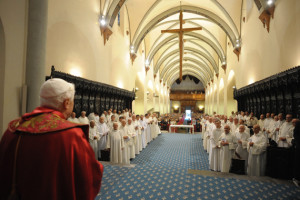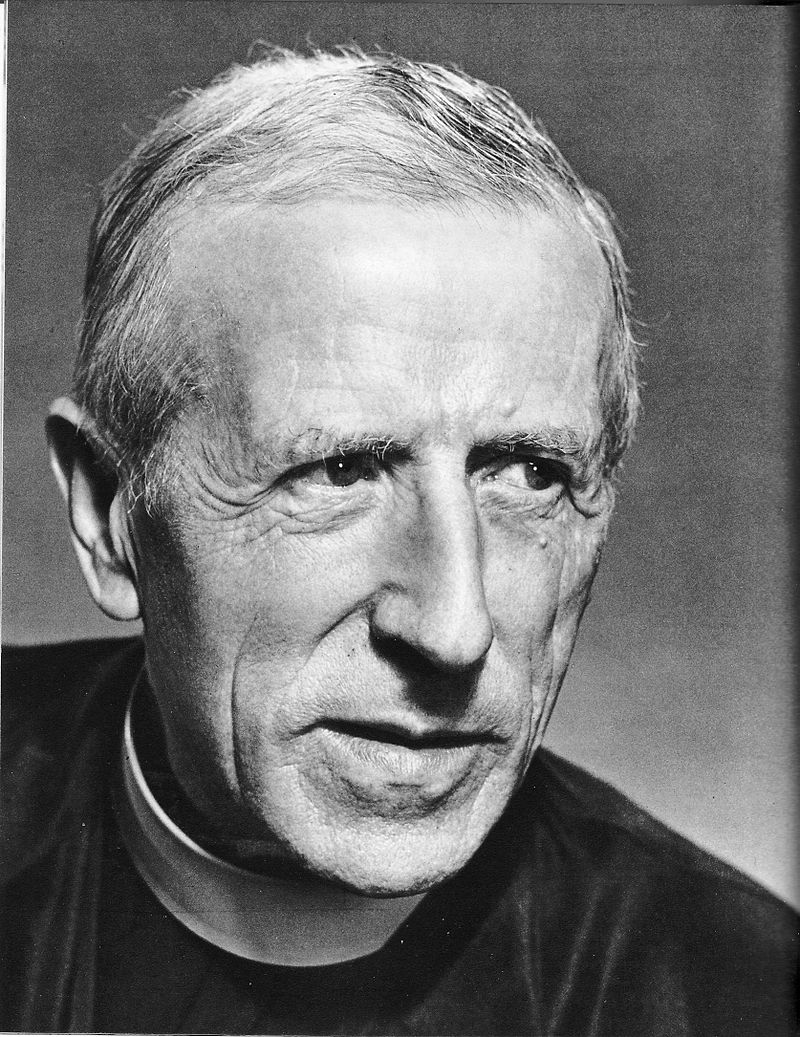 On this page we want to give an overview of the person of Teilhard de Chardin, a French paleontologist and (Catholic) priest, member of the Jesuit order. He was born on May 1, 1881 near Clermont-Ferrand in France and died in New York on April 10, 1955.
On this page we want to give an overview of the person of Teilhard de Chardin, a French paleontologist and (Catholic) priest, member of the Jesuit order. He was born on May 1, 1881 near Clermont-Ferrand in France and died in New York on April 10, 1955.
Teilhard de Chardin became a member of the Jesuit order when he was 18. Because the Jesuits were expelled from France in 1904, Teilhard de Chardin continued his philosophical and theological studies on the English Channel Island of Jersey. From 1905 to 1908 he taught physics and chemistry at the Jesuit college in Cairo. He was then transferred to Sussex, England, where he further trained in geology and paleontology. He was ordained a priest in Hastings in 1911.
During World War I, Teilhard de Chardin served as a front stretcher in the French Army. In 1922 he became professor of geology in Paris. He was a participant in numerous scientific expeditions to Asia and Africa. In 1928 he was part of the research team that discovered the hominid Sinanthropus pekinensis in China. Teilhard de Chardin would work intermittently in China until 1937.
Especially in the years after his death, Teilhard de Chardin became a cult figure. His supporters regarded him as a genius visionary, who sensed exactly what questions many of his contemporaries had. However, there was criticism from the Church. In 1950, Pope Pius XII published the “anti-modernist” encyclical Humani Generis , in which he implicitly condemned many of Teilhard de Chardin’s teachings. In 1962, the Holy Office issued a monitum (warning):
The French Jesuit went to America. There he was still allowed to think but no longer publish and not have conversations about everything that really mattered. Those last years were a painful period for Teilhard. On June 30, 1962, a few months before the opening of the Second Vatican Council, a dicastery of the Vatican Magisterium (Holy Office headed by Prefect Alfredo Cardinal Ottaviani) issued the following warning message:
“A number of works by Father Petrus Teilhard de Chardin were distributed, even after the death of the writer, which were not infrequently successful. Without passing judgment on matters concerning the sciences, it is sufficiently clear that in the fields of philosophy and theology these works are teeming with such ambiguities, even serious errors, that they clash with Catholic teaching. Therefore, the high-quality and honorable Fathers of the Supreme Congregation of the Holy Office (today: Congregation for the Doctrine of the Faith) urge all bishops, the superiors of the religious institutes, the rectors of the seminaries and the administrators of the universities to secure the spirits, especially of the young, from the dangers of the works of Father Teilhard de Chardin and his followers.”
It is mainly Teilhard’s reflections on evil and sin that are unacceptable. It was precisely for this reason that Pius XII issued the condemnation of Teilhardinism. Teilhard de Chardin is said to have reduced moral evil to a necessary evil, an “evolutionary waste product”. Sin, in his eyes, is the human experience of the Multiplicity. For Teilhard, multiplicity is a hyperphysical term for the dynamic state in which the evolutionary process necessarily finds itself. The goal of evolution is the Point Omega, a state in which Creation is fully united with the Creator through the process of internalization. But until that ultimate Oneness is achieved, there is Multiplicity. The Catholic Magisterium found this contrary to the Revelation. Sin is the result of voluntarily going against God’s commandments, and not an evolutionary state of the entire Cosmos after nootgenesis, as Teilhard de Chardin taught.
On July 24, 2009, Pope Benedict XVI, in a sermon in Aosta, fed the idea that the Magisterium might be rehabilitating Teilhard de Chardin. He adopted thoughts taken directly from Teilhard’s meditation on the cosmos as a host: This is also the great vision of Teilhard de Chardin: at the end we will experience a truly cosmic liturgy in which the cosmos becomes a living host, according to the pope in 2009. [2]. Speculations about an imminent rehabilitation in various Italian newspapers were dismissed by the Vatican: Teilhard was not heterodox and there was therefore no reason for ‘rehabilitation’. This was surprising after the teaching and publication bans that Teilhard had to contend with. According to him, he himself was allowed to enjoy the much more important pleasure that his pious wish was fulfilled: to die on Easter Sunday (1955).
Wikipedia/edited UK
Warning concerning the writings of Father Teilhard de Chardin, of the Sacred Congregation of the Holy Office (now: the Congregation for the Doctrine of the Faith)
On June 30, 1962, the Holy Office issued a monitum (warning) regarding the writings of Father Teilhard de Chardin. In response to a letter from Cardinal-Secretary of State Casaroli to the Dean of the ‘Institut Catholique’ in Paris on the occasion of the hundredth birthday of Teilhard de Chardin, on behalf of Pope John Paul II, the Holy See repeated this warning in 1981 against rumors that this warning no longer applied. The following is the text of both the monitum and cardinal Casaroli’s letter, as well as the 1981 declaration.
Exhortation of the Holy Office, 1962.
Several works by Father Pierre Teilhard de Chardin, some of which were published posthumously, are being edited and have had quite a bit of success.
Apart from judging the points concerning the positive sciences, it is sufficiently clear that the works mentioned above are overflowing with such ambiguities and even serious errors, as if they offend Catholic teaching.
For this reason, the most distinguished and respected Fathers of the Holy Office call on all bishops as well as the superiors of religious institutions, rectors of seminaries and presidents of universities, to effectively protect the spirits, especially of the youth, from the dangers posed by the work of Father Teilhard de Chardin and his followers.
Seen in Rome, from the Palace of the Holy Office, on the thirtieth day of June 1962.
Sebastian Masala, Notary
Source: https://www.ewtn.com/library/CURIA/CDFTEILH.HTM
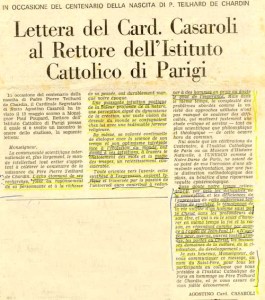 Letter from Cardinal Casaroli to the Rector of the Catholic Institute of Paris, Mgr. Poupard, on the occasion of the centenary of the birth of Teilhard de Chardin. June 10, 1981.
Letter from Cardinal Casaroli to the Rector of the Catholic Institute of Paris, Mgr. Poupard, on the occasion of the centenary of the birth of Teilhard de Chardin. June 10, 1981.
Monsignor
The international scientific community and, more generally, the entire intellectual world is preparing to celebrate the centenary of the birth of Father Teilhard de Chardin. The amazing resonance of his research, as well as the brilliance of his personality and the richness of his thinking, have deeply marked our time.
In him, a powerful poetic intuition of nature goes hand in hand with deep value, a keen perception of the dynamics of creation, and a broad vision of the making of the world with an indisputable religious zeal.
In the same way, his relentless desire to enter into dialogue with the science of his time and his bold optimism about the evolution of the world have given him intuitions – through the rich variety of his words and the magic of his images – a considerable influence.
Fully turned to the future, this synthesis, often lyrical and animated with passion for the universal, will help to restore hope to those who have fallen into disrepair. At the same time, the complexity of the problems he analyzed and the variety of approaches he adopted raise difficulties that understandably call for critical and serene study — in the scientific, philosophical, and theological fields — of his extraordinary work.
There can be no doubt that the celebration of his 100th birthday – at the ‘Institut Catholique’ of Paris, the Museum of Natural History, at UNESCO and at the ‘Notre-Dame’ of Paris – would be an opportunity from this point of view for a stimulating confrontation by a correct methodological distinction of the fields in favor of a rigorous epistemological study.
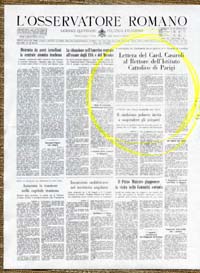 What our time will undoubtedly remember, beyond the difficulties of conception and defects of expression in this daring attempt to achieve a synthesis, is the testimony of the coherent life of a man who was deeply seized by Christ, and who took care to honor both faith and reason, and in anticipation of the call, John Paul II replied: “Do not be afraid, open wide to Christ the doors of the immense domains of culture, civilization and progress.
What our time will undoubtedly remember, beyond the difficulties of conception and defects of expression in this daring attempt to achieve a synthesis, is the testimony of the coherent life of a man who was deeply seized by Christ, and who took care to honor both faith and reason, and in anticipation of the call, John Paul II replied: “Do not be afraid, open wide to Christ the doors of the immense domains of culture, civilization and progress.
I am glad, Monsignor, to pass on this message on behalf of the Holy Father to you and to all the participants of the conference you are chairing at the Institut Catholique in Paris in honor of Father Teilhard de Chardin and I assure you of my faithful devotion.
Agostino Cardinal Casaroli (L’Osservatore Romano, 10 June 1981)
Communiqué of the Press Office of the Holy See (in the English edition of L’Osservatore Romano, 20 July 1981)
The letter from the Cardinal Secretary of State (Casaroli) to His Excellency Mons. Poupard on the occasion of the centenary of the birth of Father Teilhard de Chardin has been interpreted in a certain section of the press as a revision of previous positions taken by the Holy See with regard to this author, and in particular of the Monitum of the Holy Office of June 30, 1962, which pointed out that the author’s work contains ambiguities and serious doctrinal errors.
The question has been asked whether such an interpretation is justified.
After consulting the Cardinal Secretary of State and the Cardinal Prefect of the Congregation for the Doctrine of the Faith, who had been duly consulted in advance on the letter in question by order of the Holy Father, we are in a position to reply negatively. Far from being a revision of the Holy See’s previous positions, Cardinal Casaroli’s letter expresses a reservation in several passages – and these reservations have been concealed by certain newspapers – reservations that refer precisely to the judgment in the Monitum of June 1962, even though this document is not explicitly mentioned
Source: https://www.ewtn.com/library/CURIA/CDFTEILH.HTM
Homily of Pope Benedict during Vespers in Aosta Cathedral
In this short homily, I would like to say a few words about the prayer with which this Vespers ends; for it seems to me that in this prayer the passage from the Epistle to the Romans which has just been read is interpreted and transformed as prayer.
The prayer consists of two parts: an address – an addressee, so to speak – and then the prayer which consists of two questions.
Concluding prayer of Vespers on Friday of the fourth week, to which the Pope refers: “Almighty and merciful God, You have wanted Christ, your Son, to suffer for the salvation of the world. We pray you: awaken in your people the desire to offer themselves to you as a living sacrifice to be fully filled with your love. By our Lord
(From: Book of Hours)
No. 9.: That is exactly the content of the first part of the prayer that follows: “Make Your Church give itself to You as a living and holy sacrifice.” This question addressed to God is also addressed to us. It is a reference to two texts from the epistle to the Romans 1 In the first, Saint Paul says that we are to become living sacrifices. We ourselves, with all our being, we must be worship, sacrifice, give our world back to God and thus transform the world. The second is what Paul describes about the priestly apostolate 2 The function of the priesthood is to consecrate the world so that it might become a living host, so that the world might become liturgy: may the liturgy not be something next to the reality that is the world, but may the world itself become a living host, liturgy. And then the great vision that Teilhard de Chardin also had: at the end we will have a true cosmic liturgy, in which the cosmos has become a living host. And we pray to the Lord that He may help us to be priests in that sense to help transform the world by worshipping God, starting with ourselves. May our lives speak of God, may our lives be truly liturgy, proclamation of God, door through which the distant God becomes the near God, truly a gift of ourselves to God.
During holiday period in the Aosta Valley, 24 July 2009.
Source: http://www.rkdocumenten.nl/rkdocs/index.php?mi=600&doc=3067&id=0
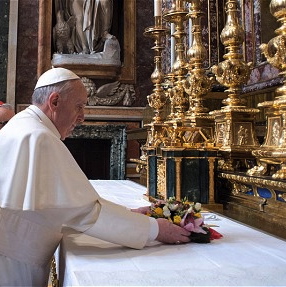 Pope Francis’ encyclical ‘Laudato Si’, ‘Be praised’ – on caring for the common home.
Pope Francis’ encyclical ‘Laudato Si’, ‘Be praised’ – on caring for the common home.
Chapter II: The Gospel of Creation,
III The Mystery of the Universe
§ 83: “The ultimate goal of the course of the universe lies in the fullness of God, which has already been attained by Christ, pivot of universal maturation.” Footnote: “In this perspective, the contribution of p. Teilhard the Chardin”.
Source: http://www.rkdocumenten.nl/rkdocs/index.php?mi=600&doc=5000&id=10199
Info: Stichting Teilhard de Chardin (The Netherlands).
- Biofides does not guarantee the theological and scientific accuracy of the information on this website of this foundation
Last edit: 8 December 2015

